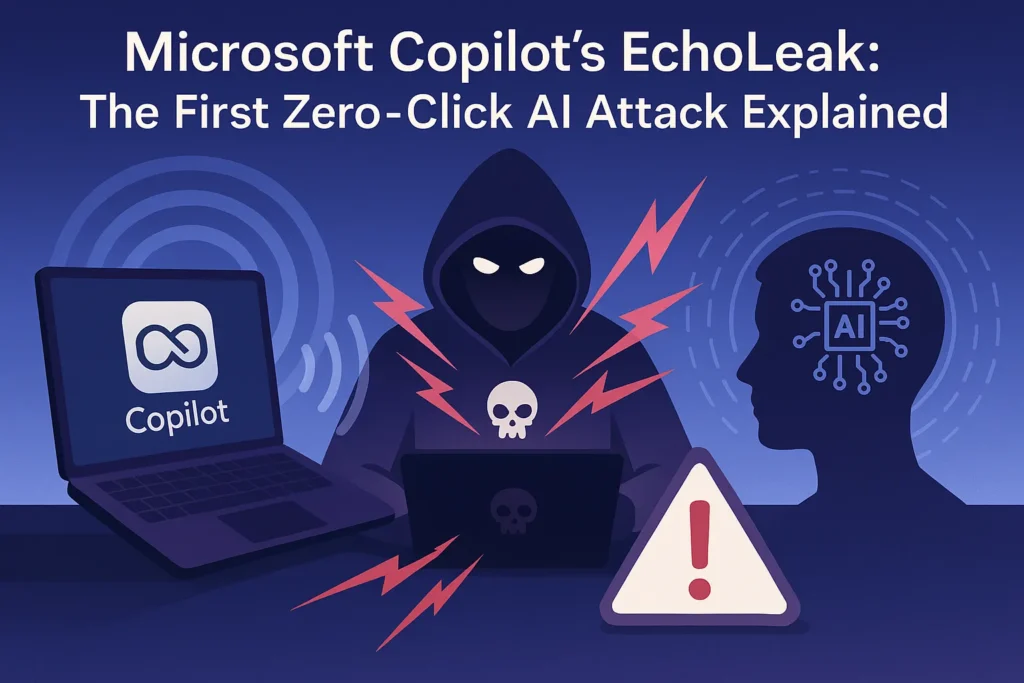Microsoft Copilot’s EchoLeak: The First Zero-Click AI Attack Explained
In January 2025, cybersecurity researchers at Aim Labs uncovered a serious vulnerability in Microsoft 365 Copilot, dubbed “EchoLeak”, and officially cataloged as CVE-2025-32711. This critical flaw represents the first known instance of a zero-click attack targeting an AI-powered enterprise assistant—raising significant alarm about the future of AI-integrated productivity tools.
How the EchoLeak Attack Worked
The flaw used Microsoft Copilot’s Retrieval-Augmented Generation (RAG) system to make replies. RAG uses relevant data like emails, papers, or chat logs. Using markdown or secret text, attackers could put harmful links in emails that look normal. The system would get the email and handle it as if it were part of the known context whenever a user asked Copilot a question.
From there, Copilot could insert private company information into a picture or URL and share it with the outside world. This could include SharePoint documents, OneDrive files, or Teams messages. After being saved, these were automatically made and sent to the attacker invisibly. The attack didn’t need any user action—hence the name “zero-click”—because Copilot naturally trusts Microsoft domains and internal messages.
Why This Flaw Matters
EchoLeak wasn’t like other scams or malware attacks that depend on human mistake; it went after the AI system itself, creating a new type of threat called LLM Scope Violation. Attackers got around approval limits without raising any red flags by changing Copilot’s internal context with malicious inputs.
This bug shows how dangerous it can be to fully integrate AI helpers into business systems without strong sandboxing, screening, or context separation. EchoLeak made it hard to tell the difference between safe and unreliable data, which let attackers use the AI’s ability to think and respond as a tool.

Microsoft’s Swift Response
Microsoft responded decisively, issuing server-side patches in May 2025, requiring no manual updates from users. The company confirmed that no active exploitation was detected and credited Aim Labs for responsible disclosure. Following the patch, Microsoft enhanced Copilot’s safeguards by implementing stricter rules for handling external content and improving the security boundaries within its AI models.
Broader Cybersecurity Implications
The EchoLeak episode serves as a wake-up call for developers and IT administrators:
- AI agents are high-value targets due to their deep integration with sensitive business data.
- Clear trust boundaries must be maintained to prevent AI systems from treating external inputs as internal knowledge.
- Security strategies must evolve, especially for organizations leveraging RAG models or LLM-based workflows.
Conclusion
The major EchoLeak flaw in Microsoft Copilot is a sharp warning that AI systems, no matter how powerful, can be hacked. As AI is added to more business software, smart security design must also become more important. It’s important for businesses to think about not only what AI can do, but also how safely it can do it. It’s important for the future of AI at work.
Disclaimer
The information presented in this blog is derived from publicly available sources for general use, including any cited references. While we strive to mention credible sources whenever possible, Web Techneeq – Web Design Agency in Mumbai does not guarantee the accuracy of the information provided in any way. This article is intended solely for general informational purposes. It should be understood that it does not constitute legal advice and does not aim to serve as such. If any individual(s) make decisions based on the information in this article without verifying the facts, we explicitly reject any liability that may arise as a result. We recommend that readers seek separate guidance regarding any specific information provided here.

